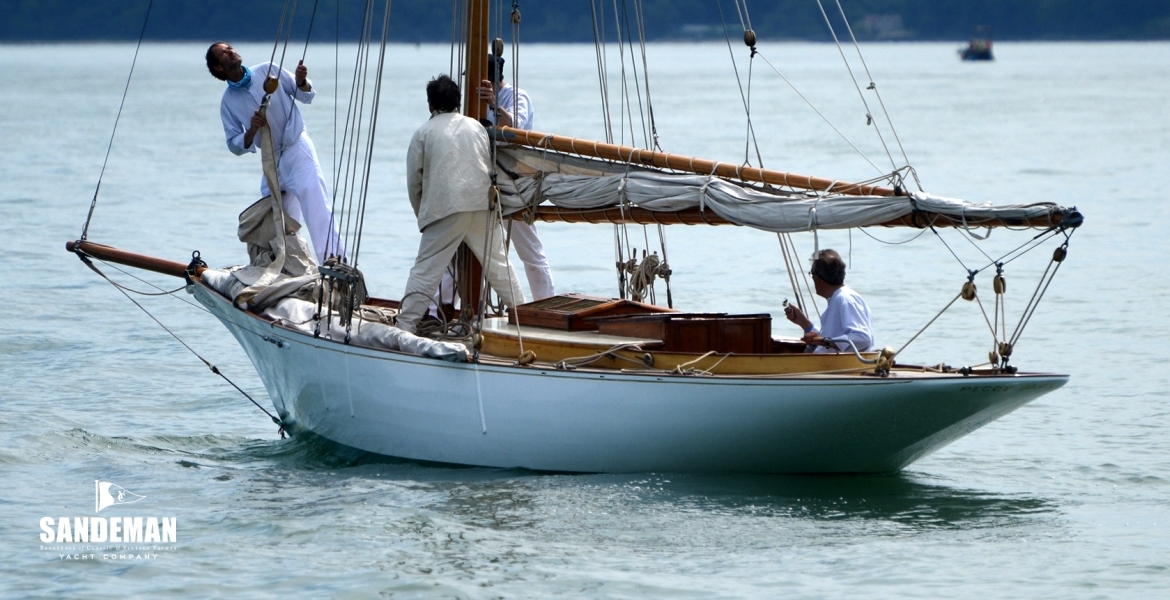

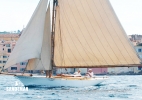
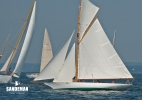
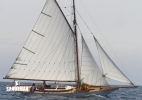
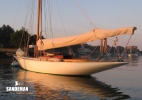
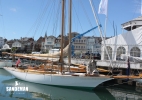
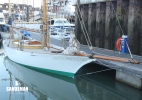
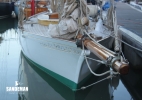


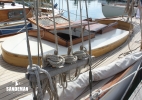

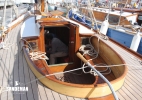
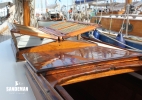
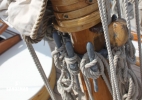
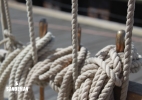
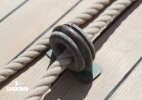

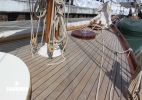
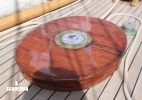
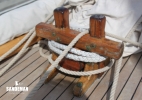
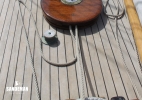
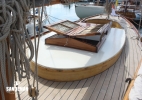
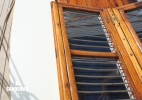

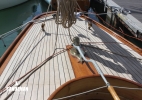
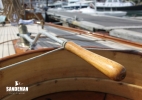
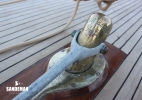

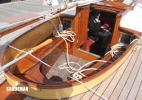
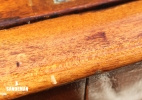
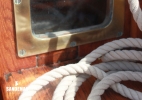
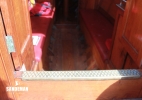
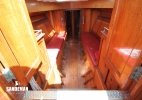
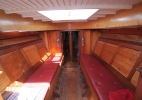
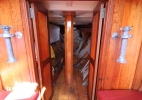
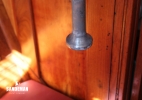
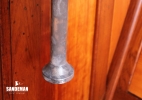

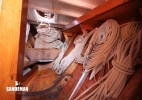

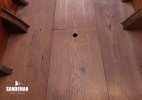
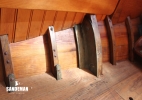
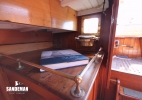
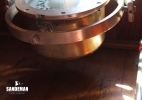
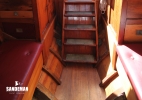

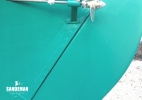
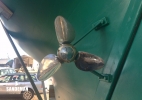
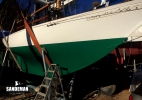
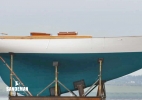
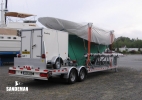
| Designer | G L Watson |
|---|---|
| Builder | John Hilditch, Carrickfergus Co Antrim, Northern Ireland |
| Date | 1894 |
| Length overall | 42 ft 6 in / 12.95 m |
| Length deck | 36 ft 0 in / 10.97 m |
| Length waterline | 23 ft 3 in / 7.09 m |
|---|---|
| Beam | 8 ft 0 in / 2.44 m |
| Draft | 6 ft 2 in / 1.88 m |
| Displacement | 5.5 Tonnes |
| Construction | Carvel Pitch pine planking on oak frames |
| Engine | Asmo Marine Thoosa 8.5 k W 48 volt DC motor |
|---|---|
| Location | United Kingdom |
| Price | EUR 300,000 |
These details are provisional and may be amended
PEGGY BAWN is a rare thing indeed. The number of surviving vessels from pioneering Clydeside yacht designer George Lennox Watson’s lifetime (1851-1904) can be counted on a careless carpenter’s fingers. Long gone are his huge America’s Cup challengers and “Big Class” racing yachts, and only two of the fleet of palatial steam yachts – the superyachts of their day – from his Glasgow drawing boards are known to survive, in fabulous condition although barely recognisable from their original appearance.
It is left to PEGGY BAWN to carry the flame for Watson’s groundbreaking mid-1890s work in setting the standard for moderation in sailing yacht design, work that has never been challenged – only endorsed by those who followed his lead through the 20th century, especially Olin J. Stephens, who was a self-confessed Watson fan.
PEGGY BAWN’s gilded “fiddle” bow was anachronistic even at her launching in 1894, partly a past fad, partly practical, undoubtedly beautiful – an interim stage in the development of extending immersed waterlines for faster sailing when heeled with a more buoyant hull – but it conceals the fact that when her award-winning restoration team began assessing what they’d found in a County Waterford hay barn in 2003, they quickly realised that the “numbers” – yacht designer speak for the various ratios that define a hull – were simply a scaled-down version of those for Watson’s famous royal racing cutter Britannia of 1893.
Her name gave rise to the so called “Britannia Ideal”, as she was and is considered the epitome of sea kindliness. PEGGY BAWN's present owner can vouch for that from fourteen seasons of racing and cruising aboard her in northern and Mediterranean Europe, and east coast USA.
PEGGY BAWN is quite simply the best behaved yacht any of them had had the pleasure to sail. And her rebuild and restoration set new standards for documentation and authenticity. She's special.
Interested in PEGGY BAWN in more detail.
Designed by G L Watson and built by John Hilditch in Carrickfergus for the Commodore of the Carrickfergus Sailing Club, J. Alfred Lepper, PEGGY BAWN was launched in 1894. Watson was the pre-eminent yacht designer of the period, having designed BRITANNIA for the Prince of Wales in 1893 as well as numerous others. He also personally raced in comparably sized yachts to PEGGY BAWN.
The yacht was very little altered and generally lightly used for most of her life. By the end of the 1990s and out of commission an abortive start on her restoration was made. The current owner purchased her in the winter of 2002-03 for complete restoration.
The owner, Hal Sisk, has previously owned and restored several sailing yachts. His project manager, Iain McAllister, is a professional yacht captain and had known of PEGGY BAWN since the early 1980s. The boat builder was Michael Kennedy, a very experienced shipwright who led a small team of other craftsmen. The consultant naval architect was the late Theo Rye, who specialised in restoration work of wooden sailing yachts. The marine engineer was Harry Hannon.
The restoration / rebuild was over two years, from April 2003, and took place in a modern, roofed and well lit workshop at Rathmoylan, Dunmore East, Co Waterford. Featured on the front covers of “Classic Boat” and “Wooden Boat”, this exemplary restoration was covered in 9 successive articles in Classic Boat. She was winner “Restoration of the Year” Germany 2006. Today she is competitive under CIM and Baltic Racing Rules.
The restoration / rebuild was over two years from April 2003 at Dunmore East, Co Waterford, Ireland, by a team of boatbuilders led by Michael Kennedy with coordination by Iain McAllister and naval architecture by the late Theo Rye.
Prior to starting the rebuild, two months were spent recording the dimensions, construction processes and materials of the original, and a full size lofting took place, recorded on CAD. In general the original work and the rebuild were done to standards exceeding those of Lloyd’s Register Yacht & Small Craft rules (although there is no evidence the yacht was ever classified).
PEGGY BAWN has been completely rebuilt to the extent that she has a completely new hull and deck atop the original lead keel. Certain sound non structural parts of the original were retained and re-used such as the fore hatch, skylight, companionway hatch, cockpit seating, the majority of the interior furniture, the tiller and rudder head and most of the rig. Since restoration she has continued to be professionally maintained.
The electric engine installation was novel at relaunch in 2005 and has proven very successful. In 2019, given the improvements in battery technology over the previous 14 years, the opportunity was taken to replace the original 8 x AGM batteries weighing 240kg with 4 x lithium batteries, all on top of the keel - reducing the battery weight by about a third, with the result that PEGGY BAWN sits on her true waterline again.
This is a summary of the essential construction elements. Comprehensive details and descriptions of materials used – and in the restoration are available on request.
- Pitch pine carvel planking over grown oak frames and intermediate steamed timbers
- Rudder of teak stock with teak and oak blade
- Bronze and copper fastenings
- New nickel aluminium bronze floors
- Eastern white pine deck over larch and Douglas fir beams
- Teak top strake, covering board and cockpit, oak deck house
- Lead keel (50% ballast ratio)
- Bronze deck fittings
- Original iron tiller and engraved brass rudder stock cap
90% original interior
- Interior accessible via the companionway or fore hatch
- From aft, the companionway steps lead down to the accommodation below
- Under the companionway is the electric motor, screened from view but not separately boxed
- Matched pair of sideboards port and stbd; drawers and stowage accessible from forward
- 2 x Full length settees fwd with stowage under and outboard via lift out and hinged panels
- Small fold up edge piece to extend the seat width for sleeping
- Removable bare boarded cabin sole
- Panelled full beam bulkhead forward of the seats
- 2 x forward opening doors set in the middle for access forward
- Foc’sle simply laid out
- Plate rack to starboard
- Bench seat to port; 2 x simple lockers aft; stowage shelf starboard
- Teak Chain locker on original base
The rig is gaff cutter; the mast, bowsprit, boom and spinnaker pole all well built spars, solid and built up of nice lengths of timber; scraped and refinished. The gaff and topsail yard are new solid spars from Collars Ltd. The retained fittings of galvanised iron or steel include the gooseneck bands, gaff throat straps, mainmast irons and sheave. New galvanised mild steel items include the gooseneck straps and boom clew iron. There is a new bowsprit cranse iron in cast bronze. The bobstay hull fitting is a forged bronze fitting, screwed to the stem, linking to a forged and adjustable bronze bobstay rod. The mast is stepped by a simple tenon and there is a bronze bar deck strut under deck.
The standing rigging is unpolished 7 x 7 stainless steel hand spliced with collar and shackle eyes aloft and custom bronze bottle screws below. The rigging was all specified and fitted by Peter Martin, ex of Spencer Rigging Ltd, a professional rigger specialising in traditional work. The all new running rigging is a tan-coloured three strand Polypropylene
There is provision for a mainsail, staysail, jib, long roper jib, topsail and spinnaker. The staysail is set on a forestay, where the jib is set flying on a traveller to the bowsprit end. The \"long-roper\" jib is a full hoist on the topmast forestay light airs ghosting sail with sheet lead via the leeward mainsheet cleat.
Dacron sails by Ratsey & Lapthorn
- Mainsail (with two reefs) 383 sq ft / 35.58 sq m
- No 1 jib 117 sq ft / 10.87 sq m
- No 2 jib
- Long roper jib
- Staysail 75 sq ft / 7 sq m
- Jackyard topsail 86 sq ft / 8 sq m
- Balloon jib
Similar set of cotton sails purchased with the yacht, made by Perry’s of Dún Laoghaire, dated 1957 and 1958, but little used and in remarkable condition. There is no cotton long roper
CANVASWORK
- Hatch covers
- Boom cover
- Cast bronze gammon iron forward, with gated rollers each side for anchoring and mooring
- Cast bronze eye plate fitting right forward, through-bolted, for the straddled end of forestay
- Bowsprit heel fitting through-bolted bronze plate supporting a traditional set of “H” bitts
- Removable bowsprit secured with an oak fid
- Cast bronze chain pipe to starboard
- Original foredeck teak hatch with removable oval hatch top on centreline
- 4 x Cast bronze eyebolts at mast; the forward two linked into the mast strut rod below decks
- Mast wedged and booted through the deck and well supported
- 2 x cast bronze whisker stay chain plates, screwed fastened with silicon bronze screws
- Chain plates thru-bolted with new ½ inch bronze bolts for cap, lower shrouds and backstays
- Jib sheet leads are through holes bored in the toe rail
- Staysail leads are to a pair of traditional bulls-eye fairleads
- Hardwood timber cleats for the runners and mainsheet
- Bronze cleats on the coaming side for the headsail sheets
- Bronze quarter blocks and mainsheet horse, all through bolted
- 2 x Fortress anchors
- 10 m heavy 5/8th inch chain and 25 mm diameter 3-strand warp
- c 50 m 8 mm anchor chain
- Adequate warps and other lines
- Fenders for mooring and towing
- Asmo Marine Thoosa 8.5 kW 48 volt DC motor, driving via a belt driven reduction gear
- Conventional 25 mm 316 stainless steel shaft, offset via custom stern gland to port
- External clamp coupling enables tail shaft to be removed
- Custom welded stainless steel removable “A” bracket
- 14 in diameter three-bladed feathering Darglow propeller
- Max speed c 5 knots +
- Motor control lever is located in the port cockpit locker.
- Battery switch forward in port cockpit locker.
- 4 x Lithium batteries 48 V 25 Ah LiFe PO4 Power Brick Pro
- Lithium battery charger 48 V 15 A Controller
- BMV 700 battery monitor
- Gimballed unlit compass mounted to be visible from the cockpit with port and stbd mounts
- Hand bearing compass
- Handheld GPS
- VHF
- Barometer
- 1 x Horseshoe life buoy
- 4 x Life jackets with integral harnesses
- 2 x double ended harness lines
- Aerosol fog-horn
- Jabsco Amazon Warrior double action bilge pump; outlet over the hull side
- Johnson L650uc auto electric bilge pump; outlet over the hull side (2019)
Peggy Bawn’s custom-built “5th wheel” articulated king-pin trailer was made in 2007 by leading German boat trailer specialist Harbeck, based on their SA100 type. It adds several dimensions to her security - in transit and in storage - and makes her eminently suitable for attending events worldwide. The trailer is very much part of the “package.”
The initial raison d’être was driven by the desire to ship her across the Atlantic for a season in east coast US waters by the safest means possible: inside a roll-on-roll-off ship. Usually boats must be lifted at the port from the delivering truck to one of the ship’s “Mafi” trailers in a secure area without the possibility of personal supervision. These are hard-wheeled, no-suspension low loaders which are shunted onto the ship by tractor units. As the trailers are often shorter than the boat, in the event of an unplanned “shunt”, there is the possibility of the boat being damaged fore or aft by touching adjacent cargo. Then the reverse process at the arrival port…
This trailer is longer and wider than the boat, thereby protecting her from such shunting. Moreover because loading and unloading only ever happens under personal supervision at a boatyard, instead of a secure port compound with no possibility for access, all means can be taken to reduce the chance of damage.
Another advantage of having her own trailer is that the boat can be prepared for haulage in good time, without an impatient trucker hanging around. Typically therefore everything is prepared for uplift days before the haulier is due, allowing, among other things, time for the boat’s minder to get to the next destination in time.
A timber tie-down frame is designed so that its four carpeted pads sit on the deck. At four points, tie-down straps lead from the trailer up and round the ends of two athwartships spar parts of this frame and back down to the trailer, meaning that no straps cross the boat, the capping rail is protected and the tie-down is positively vertical at four points. Further straps are then not required at her sensitive overhangs. There is a transport cover made to her lines, with deep sides to protect the topsides from the elements, and the whole vessel from potentially rusty deck-head drips, ship funnel and truck exhaust soot, and general transportation pollution.
Since 2007, Peggy Bawn has travelled on her trailer from Denmark to Maine via Bremerhaven and Baltimore; from New York to Denmark via Baltimore and Gothenburg; from Denmark to the Clyde via Esbjerg-Immingham; from Ardfern, west coast of Scotland to Plymouth & Falmouth; from Falmouth to Denmark via Harwich-Esbjerg; from Denmark to Lymington via Esbjerg- Harwich; from Fowey to Denmark via Harwich-Esbjerg; from Denmark to – all without even the slightest damage.
In winter storage, Peggy Bawn is always sitting on her own substantial cradle – with three keel and six hull supports - which is incorporated into the trailer but removable. The cradle was originally made during the rebuild and is strong enough to be used for craning her from four lifting points, using her own spreader bars if necessary. It also supports her with the waterline level (impossible otherwise because of her “v” profile), allowing drainage of any accumulated water in the non-self-draining cockpit to run off via the bilge sump bung. The centre, longitudinal, keel supporting member is designed to be unbolted from the rest of the cradle to be used in the keel trough of a specialised commercial transport yacht trailer, keeping her level to waterline as above.
The trailer is designed for winching up a Brenderup “Cargo” box trailer onto the rear section, under Peggy Bawn’s counter overhang, using a custom ramp system. This shelved box trailer serves as a secure, dry store in transit, especially for her cotton sails. For the return voyage to USA it satisfied the voyage insurers that everything loose and valuable was locked up – because Peggy Bawn does not have a lock at her companionway.
There is further information including detailed plans with dimensions and compliance with various national road etc regulations available on request.
- Harbeck Trailer described in detail above
- Brenderup box trailer shelved-out as bosuns stores fits on main trailer
- Buckets
- Paddles
- Bosuns chair
- Boat hook
Contact us to discuss PEGGY BAWN in more detail.
These particulars have been prepared from information provided by the vendors and are intended as a general guide. The purchaser should confirm details of concern to them by survey or engineers inspection. The purchaser should also ensure that the purchase contract properly reflects their concerns and specifies details on which they wish to rely.